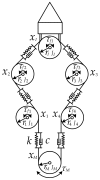A Novel Position Compensation Scheme for Cable-Pulley Mechanisms Used in Laparoscopic Surgical Robots
- PMID: 28974011
- PMCID: PMC5676776
- DOI: 10.3390/s17102257
A Novel Position Compensation Scheme for Cable-Pulley Mechanisms Used in Laparoscopic Surgical Robots
Abstract
The tendon driven mechanism using a cable and pulley to transmit power is adopted by many surgical robots. However, backlash hysteresis objectively exists in cable-pulley mechanisms, and this nonlinear problem is a great challenge in precise position control during the surgical procedure. Previous studies mainly focused on the transmission characteristics of the cable-driven system and constructed transmission models under particular assumptions to solve nonlinear problems. However, these approaches are limited because the modeling process is complex and the transmission models lack general applicability. This paper presents a novel position compensation control scheme to reduce the impact of backlash hysteresis on the positioning accuracy of surgical robots' end-effectors. In this paper, a position compensation scheme using a support vector machine based on feedforward control is presented to reduce the position tracking error. To validate the proposed approach, experimental validations are conducted on our cable-pulley system and comparative experiments are carried out. The results show remarkable improvements in the performance of reducing the positioning error for the use of the proposed scheme.
Keywords: backlash hysteresis; cable-pulley system; position compensation; support vector machine.
Conflict of interest statement
The authors declare no conflict of interest.
Figures















References
-
- DiMaio S., Hanuschik M., Kreaden U. Surgical Robotics. Springer; Berlin, Germany: 2011. The da Vinci surgical system; pp. 199–217.
-
- Guiochet J., Tondu B., Baron C. Integration of UML in human factors analysis for aafety of a medical robot for tele-echography; Proceedings of the 2003 IEEE/RSJ International Conference on Intelligent Robots and Systems (IROS 2003); Las Vegas, NV, USA. 27–31 October 2003; pp. 3212–3217.
MeSH terms
LinkOut - more resources
Full Text Sources
Other Literature Sources

